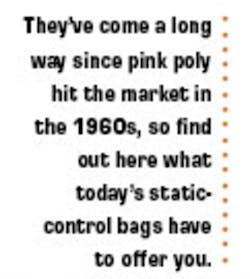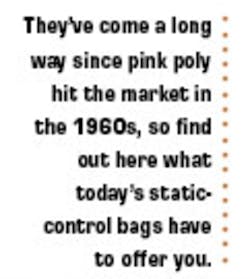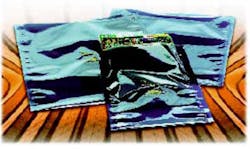With ever increasing operational speed and more functionality, newly developed electronic products are extremely sensitive to their surroundings. As a result, susceptibility to damage from static discharge has become a critical issue, and storage bags play an important role in addressing the static-generated problems.
In selecting the optimum bag for an application, evaluate the trade-offs and decide which characteristics are most important. For example, if you use a barcode reader, transparency is very important. An opaque solid foil bag may have some characteristics especially important to you, but without the ability to read bar codes through the film, it is not the solution you need.
Your alternative, a transparent bag, gives readability but may not protect the contents from moisture. The transparent film’s permeability to dampness, specified as the moisture vapor transfer rate (MVTR), is likely to be quite poor.
You can choose from several types of ESD-control bags. The lowest cost polyethylene material, commonly known as pink poly, offers some protection but no shielding. A step up is the black poly bag with some shielding. Multilayer metallized bags are transparent and have excellent static protection but offer very little defense against humidity. For such protection, the moisture vapor barrier (MVB) bag is available.
Pink and Black Poly Bags
Starting in the 1960s, pink bags made with a polyethylene plastic loaded with a chemical antistat were the first products for ESD storage. The pink coloring of the transparent film simply is an additive to denote the bag is made of dissipative material and has static-control properties.
The pink poly bags are low charging and dissipative but have no shielding capability. Even so, they still are useful for packaging ESDsusceptible components and products that have relatively high withstand voltages.
As a low-cost improvement over pink poly, some bags are made of an opaque polyethylene plastic volume- loaded with conductive carbon. This black poly bag is highly conductive, with a typical resistance of 103 Ω to 104 Ω. This provides some shielding, but the low resistance can cause problems in static control because it bleeds off a static charge very rapidly.
In most applications, single-layer pink and black bags have been replaced with multilayer metallized containers. These products provide shielding, and some have moisture barriers.Metallized Bags
Metallized shielded bags, like their polyethylene cousins, are low charging, often called dissipative. They go beyond this, however, to add a metal shield layer and a polyester dielectric layer to prevent static charges from penetrating the bag.
One generic type of shielded bag is metal-in, where the metal layer lies between plastic sheets. Typically, the outer layer will be dissipative polyester, and the inner can be dissipative polyethylene. Usually, the metal is aluminum, but in some cases, it may be copper or nickel.
In a metal-out bag, the conductive layer of metal on the outside may be aluminum or nickel, generally protected by an abrasion-resistant coating. The center is a polyester film and the inside layer dissipative polyethylene. The metal-in container generally is more durable and less expensive than the metal-out alternative.
The best film for metallized bags has a low anion content and doesn’t contain topically treated antistats such as chlorides and nitrates. It is made with an extrusion lamination process. Rather than solvent-based adhesives that could outgas, the laminating process uses a layer of molten plastic to seal the layers of film together. The polyethylene is an inherently stabile, inert material.
Polyester and polyethylene components are not inherently low charging. As a result, some shielding bags have an amine-based antistatic agent bonded to the inside layer.
This, however, has a disadvantage. Stored parts may rub off the antistat agent as the bags are transported. This can lead to tribocharging or generation of a static charge as the stored device rubs against the exposed layer. This almost certainly will damage static-sensitive contents. Also, the chemical additive in this agent may cause metal corrosion and stress cracking.
Important ESD bag characteristics are tested to verify conformance with the appropriate specifications. A good starting point is ANSI/ESD S11.31-2001: Evaluating the Performance of Electrostatic Discharge Shielding Bags.
Bag details can be tested with readily available standards. For example, “Electrical resistance is categorized by ESD STM 11.11-2001: Surface Resistance Measurement of Static-Dissipative Planar Materials,” noted Mike Malkasian, packaging product manager at Desco Industries. “Static decay can be measured per FTM Standard 101C, Method 4046.1: Test Procedures for Packaging Materials; Electrostatic Properties of Materials.
“ANSI/ESD S11.31-1994, ESD Shielding Materials—Bags,” he said, “describes the test of a bag or other enclosure that limits the passage of current and attenuates the electromagnetic field caused by an electrostatic discharge. This also is known as Faraday-cage penetration.
“Measurement of tear resistance,” Mr. Malkasian continued, “is defined by the American Society for Testing Materials (ASTM) D 1922: Test Method for Propagation Tear Resistance of Plastic Film. The important MVTR can be measured per ASTM F1249-90: Standard Test Method for Water Vapor Transmission Rate Through Plastic Film.”
Protection From Moisture
Some shielded bags add a moisture barrier to help maintain the static-control properties in the presence of humidity. One type of MVB bag has a dissipative outer layer such as nylon, a second layer of metal, a third of polyester, and an inside lining of dissipative polyethlene.
The second type uses dissipative Tyvek™ on the outside and a more puncture-resistant second layer. The third and fourth layers are polyester and dissipative polyethylene. The metal layer is about 10 times as thick as that in the ordinary metallized bags, and moisture control can be 20 to 60 times as good.
As a helpful byproduct, moisturebarrier bags contain less contaminants than the typical shielded bags. This is significant because most electronic circuits now use silver-based alloys rather than lead-based. Silver circuits corrode faster when exposed to the chlorides and nitrates frequently found in the older types of bags.
“The disk-drive industry,” according to David E. Swenson, senior specialist at the 3M Electronic Handling & Protection Division, “has special problems and has been the most vigorous in demanding better packaging materials. A typical set of requirements is low outgassing; low particulate levels (<1-micron or possibly 2-micron particles); low, nonvolatile residue (NVR); and low extractable ionic levels. The industry also needs an MVTR <0.02 g/100 in.2/24 h, Static-Control Bags shielding <10 nJ (ANSI/ESD S11.31: ESD Shielding Material—Bags), and a surface resistance <1 × 1011 Ω. “Other segments of the electronics industry,” he continued, “ask for some or all of these characteristics. For example, the semiconductor industry has many of the same requirements, except an MVTR <0.003g/100 in.2/24 h.”What’s Next?
Over the past two years, film and bag manufacturers have made significant headway in developing new film formulations that produce ultraclean bags. “Typically, a newer product has an MVTR of about 0.0003,” Ed Weggeland, vice president of marketing at Richmond Technology, noted, “and particle content is extremely low both inside and outside the bag. The nonvolatile residue measures <1.0 mg/ft2, outgassing <1.0 ppm, and ionics <1 ppm. It is reasonable to expect these trends will continue since the components to be protected are becoming smaller and more susceptible to ESD.”Static-Control Bags
Metal-In Bag
The Statshield® Metal-In Premium Bag has 40% light transmission to facilitate bar coding. With a low anion content, the material doesn’t contain topically treated antistat agents that can cause contamination. The extrusion process eliminates solvent-based, outgas-prone adhesives. The NVR is <1.0 cm2, ionic content <10 ng/cm2, and outgassing <500 ppm. Charge decay is <0.01 s, shielding <15 nJ, and typical dissipative resistance 1010 Ω. Desco Industries, 781-821-8370, www.rsleads.com/203ee-223Moisture Barrier Bag
The DryPack™ 3750 Moisture Vapor Barrier Bag has a dissipative outer layer of biaxially oriented nylon, a solid aluminum foil middle layer, and an inner layer of antistatic polyethylene. It is used for SMD tape-and-reel storage, quad flat pack/JEDEC trays, and component shipping tubes. Several sizes are standard. An ultraclean version also is available. Richmond Technology, 800-829-2942, www.rsleads.com/203ee-224
Clean Bag
The 3370 Moisture Barrier Bag uses a 3.6-mil film for tensile strength and resistance to punctures and tears. It contains no amines, amides, or silicone derivatives, and the ionic contamination from outgassing is compatible with clean-room environments. Moisture protection is better than the requirements of EIA 583 Class I. The bag comes in several standard sizes from 4” × 6” to 18” × 24”. 3M Electronic Handling & Protection Division, 800-328-1368, www.rsleads.com/203ee-225
For More Information For more information on this topic, visit our website at www.evaluationengineering.com and access the Article Archives.
March 2002



